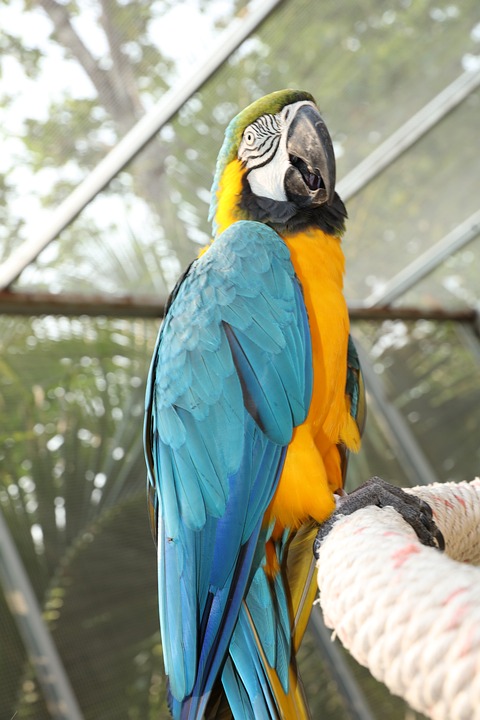Header: Parrot Behavior – How to Discourage Excessive Possessiveness Towards Toys and Food
Introduction:
Parrots are highly intelligent and social creatures with a natural tendency to become possessive of their belongings, including toys and food. While some possessiveness is normal and healthy, excessive possessiveness can lead to aggressive behavior and territoriality. In this article, we will explore effective strategies to discourage excessive possessiveness in parrots, promoting a harmonious environment for both the bird and its human companions.
I. Understanding Possessive Behavior in Parrots
A. Normal vs. Excessive Possessiveness
Parrots naturally exhibit possessive behavior to some extent, as it is a survival instinct. However, when possessiveness becomes excessive, it can lead to behavioral issues and negatively impact the parrot’s overall well-being.
B. Causes of Excessive Possessiveness
Several factors can contribute to excessive possessiveness in parrots, including insecurity, lack of socialization, previous experiences, and hormonal changes. Understanding the underlying causes is essential in addressing and modifying this behavior.
C. Identifying Signs of Excessive Possessiveness
Recognizing the signs of excessive possessiveness is crucial for early intervention. These signs may include aggression, biting, territorial behavior, excessive screaming, or refusing to share toys or food.
II. Strategies to Discourage Excessive Possessiveness
A. Consistent and Structured Routine
Establishing a consistent daily routine can provide a sense of security for the parrot and help reduce possessiveness. Regular feeding times, play sessions, and socialization can promote a more balanced behavior.
B. Positive Reinforcement and Reward-Based Training
Using positive reinforcement techniques, such as treats or praise, can help redirect possessive behavior. Rewarding the parrot for sharing or displaying non-possessive behavior encourages them to continue these actions.
C. Encouraging Sharing and Socialization
Creating opportunities for socialization with other parrots or humans can help reduce possessiveness. Encouraging the parrot to interact and share toys or food with others promotes a sense of community and reduces territoriality.
D. Rotating Toys and Food
Regularly rotating the parrot’s toys and food can help prevent possessiveness. Introducing new items and removing old ones prevents the parrot from becoming overly attached to specific items.
E. Engaging Parrot in Interactive Play
Engaging the parrot in interactive play, such as puzzle toys or training sessions, can redirect their focus from possessiveness. This helps stimulate their mind and provides a positive outlet for their energy.
III. Addressing Specific Scenarios
A. Possessiveness Towards Toys
1. Gradual Introduction of New Toys
Introducing new toys gradually allows the parrot to adjust and reduces possessiveness towards specific items.
2. Teaching the “Trade” Command
Teaching the parrot to exchange one toy for another using the “trade” command helps foster a non-possessive behavior and encourages sharing.
3. Implementing Toy Rotation System
Implementing a toy rotation system ensures that the parrot has a variety of toys to play with, reducing possessiveness towards specific items.
B. Possessiveness Towards Food
1. Establishing Set Feeding Times
Establishing a consistent feeding schedule helps reduce possessiveness towards food. The parrot learns that food will be provided regularly, eliminating the need for excessive possessiveness.
2. Utilizing Foraging Toys and Puzzle Feeders
Using foraging toys and puzzle feeders engages the parrot’s natural foraging instincts. This helps distract them from possessive behavior and provides mental stimulation.
3. Sharing Meals with Your Parrot
Sharing meals with your parrot promotes a sense of bonding and reduces possessiveness towards food. Allowing the parrot to eat alongside you can help them feel included and less possessive.
IV. FAQs (Frequently Asked Questions)
A. How long does it take to reduce possessiveness in a parrot?
The time it takes to reduce possessiveness in a parrot can vary depending on the individual bird and the consistency of training. It may take weeks or even months to see significant improvements.
B. Can possessiveness in parrots be completely eliminated?
While it may not be possible to completely eliminate possessiveness in parrots, it can be significantly reduced through consistent training and environmental enrichment.
C. What are some signs that my parrot is becoming less possessive?
Signs that your parrot is becoming less possessive may include a willingness to share toys or food, decreased aggression, and increased socialization with other parrots or humans.
D. Is punishment an effective method to discourage possessiveness?
Punishment is not recommended as it can worsen possessive behavior and damage the trust between the parrot and its owner. Positive reinforcement and reward-based training are more effective and humane approaches.
E. Can professional trainers help with excessively possessive parrots?
Yes, professional trainers with experience in parrot behavior can provide valuable guidance and tailored training programs to help address excessively possessive behavior in parrots.
Conclusion:
Discouraging excessive possessiveness in parrots is crucial for their overall well-being and healthy interaction with their human companions. By understanding the causes and signs of excessive possessiveness and implementing the strategies outlined in this article, you can create a positive and enriching environment for your parrot. Remember, patience and consistency are key when modifying behavior, and seeking professional guidance can be beneficial in challenging cases.









